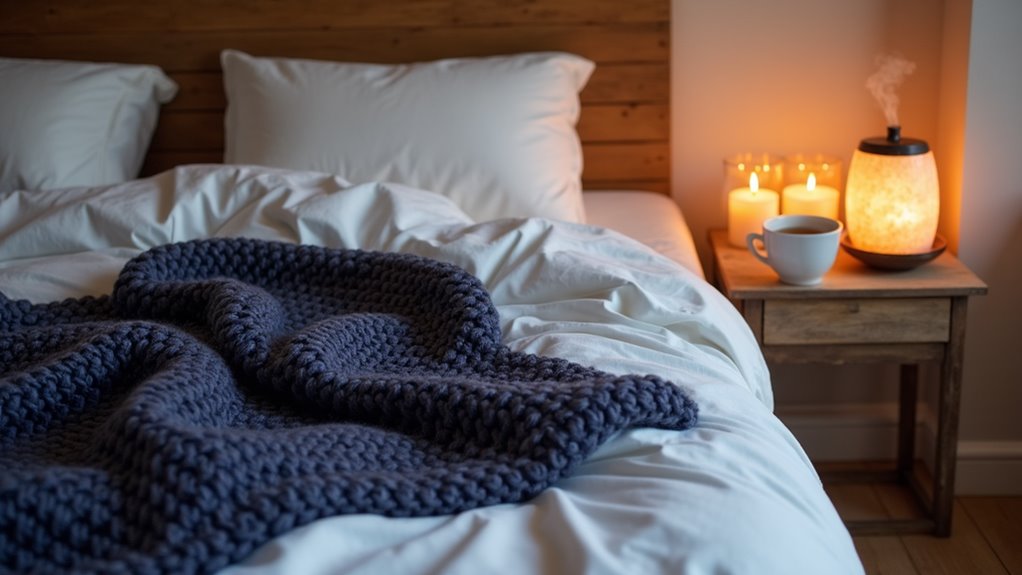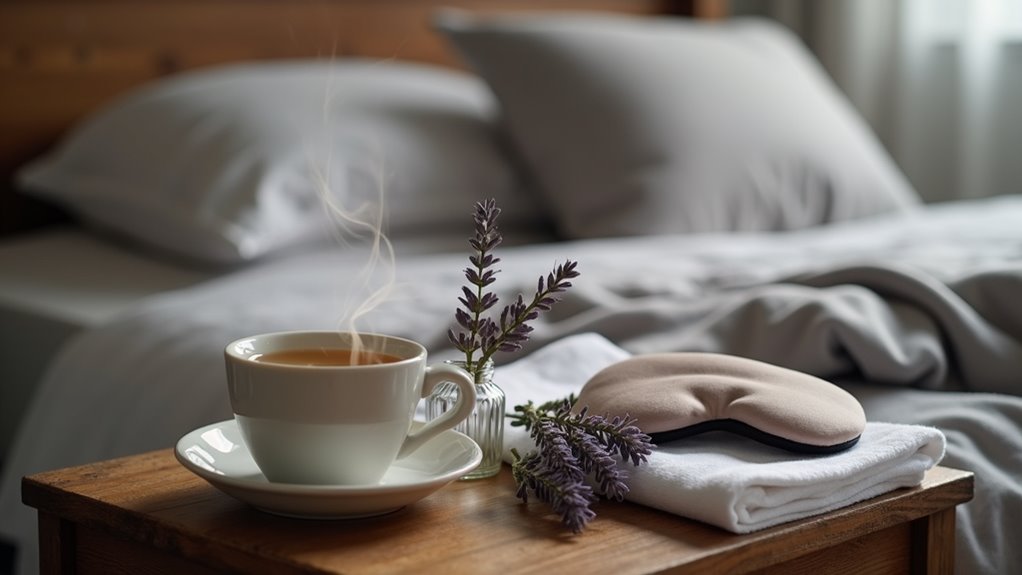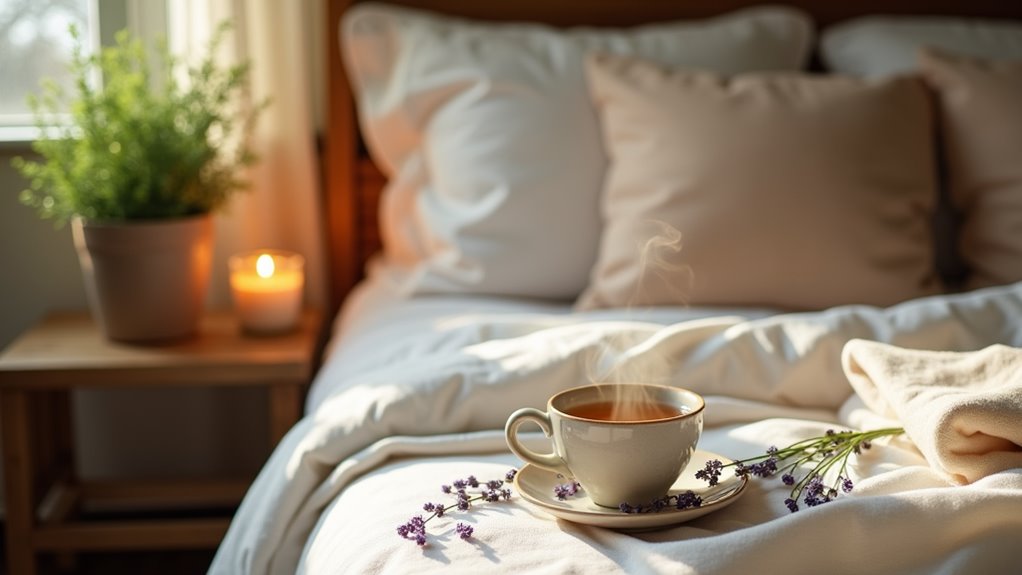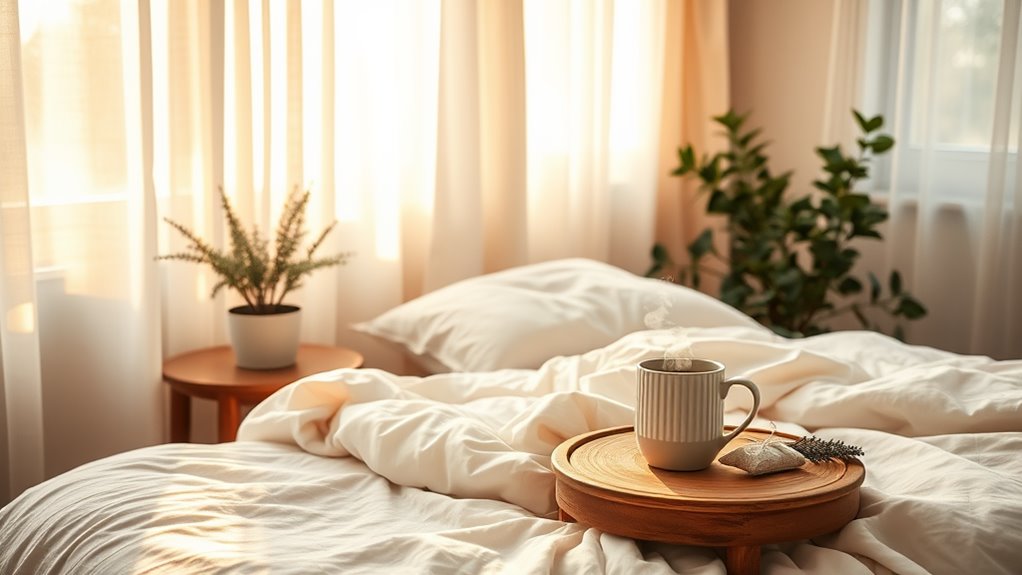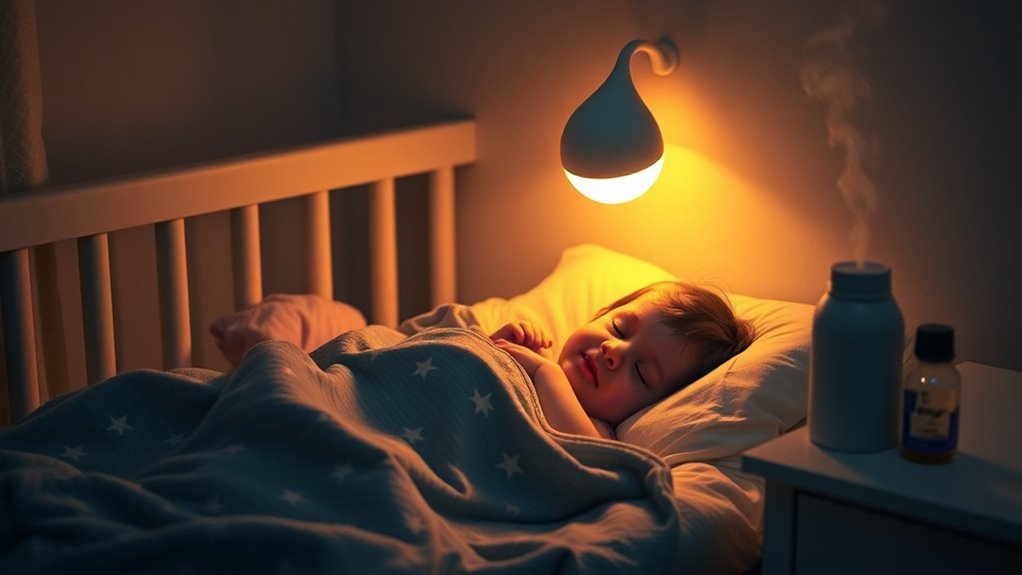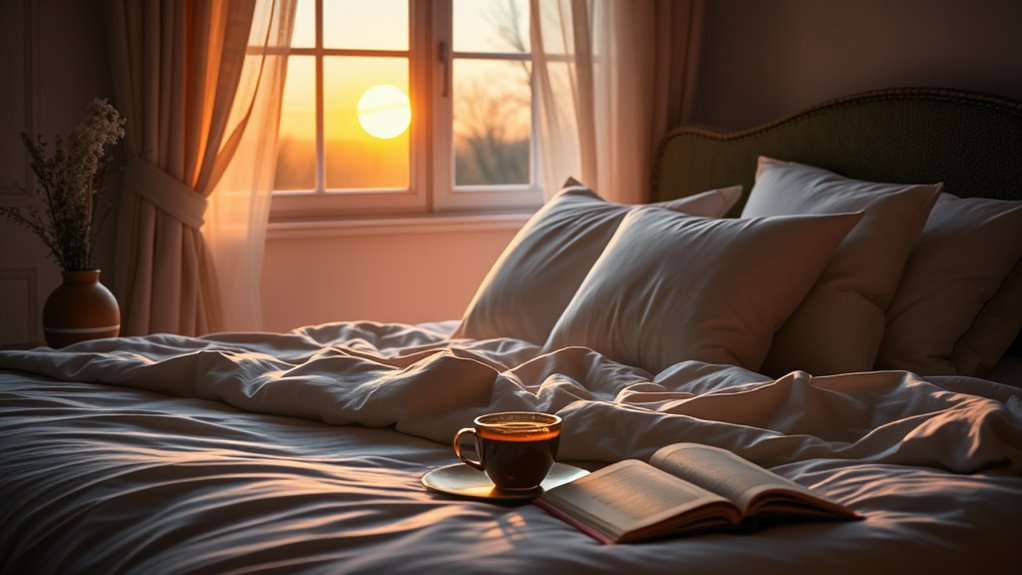What Helped Me Sleep When Nothing Else Worked
You’ll see dramatic sleep improvements by targeting three core areas that most people overlook. Start by setting your bedroom temperature between 65-68°F, implement a strict “digital sunset” two hours before bed, and establish a consistent evening routine with relaxation techniques like the 4-7-8 breathing method. Combine these with magnesium supplementation and morning exposure to natural light. These evidence-based solutions transformed countless former insomniacs’ nights from restless to restorative, with deeper insights awaiting those ready for change.
My Decade-Long Battle With Sleepless Nights
Have you ever stared at the ceiling for hours, watching shadows dance while sleep remains elusive? You’re not alone. Studies show that 30% of adults struggle with chronic insomnia, and I was one of them for ten years.
During my battle with sleeplessness, I tried countless natural sleep remedies – from chamomile tea to lavender oils. Nothing seemed to work consistently.
My days became foggy, and my nights turned into anxiety-filled marathons of tossing and turning. Medical tests revealed no underlying conditions, yet quality sleep remained out of reach.
This frustrating journey led me to explore evidence-based solutions that finally helped.
Like many others suffering from sleep issues, I discovered that magnesium deficiency could be contributing to my restless nights, especially as a middle-aged adult.
Breaking Free From Sleep Medication Dependency
If you’re ready to break free from sleep medication dependency, you’ll need a structured plan to gradually reduce your dosage while implementing natural alternatives.
You can work with your healthcare provider to create a safe tapering schedule that minimizes withdrawal effects and maximizes your chances of success.
As you decrease medication use, you’ll simultaneously build sustainable sleep habits through relaxation techniques, consistent bedtime routines, and evidence-based behavioral changes.
The 4-7-8 breathing technique naturally activates your body’s relaxation response to promote deeper, medication-free sleep.
Tapering Off Sleep Pills
While prescription sleep medications can provide temporary relief from insomnia, long-term use often leads to tolerance and dependency.
To safely discontinue sleep medication, you’ll need to work closely with your healthcare provider to create a personalized tapering schedule.
Your doctor will typically reduce your dosage by 25% every two weeks, monitoring your response and adjusting as needed.
During this process, you’ll want to implement sleep hygiene practices and cognitive behavioral therapy techniques to manage any rebound insomnia.
Most patients can successfully discontinue sleep medications within 2-3 months when following a structured tapering plan.
Finding Natural Sleep Solutions
Breaking free from sleep medication dependency requires a comprehensive approach focused on natural sleep solutions that work with your body’s biological rhythms.
Start by establishing a consistent sleep schedule that aligns with your circadian rhythm. Create an environment conducive to sleep – dark, quiet, and cool (65-68°F).
Practice evidence-based relaxation techniques like progressive muscle relaxation or deep breathing exercises. Incorporate sleep-promoting supplements like magnesium, valerian root, or melatonin under medical supervision.
Regular exercise, particularly in the morning or early afternoon, can regulate your sleep-wake cycle.
Limit screen exposure before bedtime and develop a calming pre-sleep routine that signals your body it’s time to rest.
Building New Sleep Habits
Transitioning away from sleep medication requires gradual, systematic changes to establish sustainable sleep habits.
You’ll need to work closely with your healthcare provider to develop a personalized tapering schedule that minimizes withdrawal effects.
Start by implementing consistent sleep-wake times, even on weekends.
Create a wind-down routine that signals your body it’s time to sleep: dim lights, avoid screens, and engage in calming activities like reading or gentle stretching.
Set your bedroom temperature between 60-67°F, use blackout curtains, and remove distracting devices.
Track your sleep patterns and symptoms in a diary to identify triggers and measure progress.
The Unexpected Power of Bedroom Temperature
Three key scientific studies have revealed that bedroom temperature plays a more critical role in sleep quality than previously understood.
Research confirms that maintaining your bedroom between 65-68°F (18-20°C) optimizes your body’s natural sleep cycle.
You’ll notice significant improvements by lowering your thermostat an hour before bedtime. Your core temperature needs to drop by 2-3 degrees for optimal sleep onset.
Installing a programmable thermostat, using breathable bedding, and placing a fan strategically can help maintain this ideal range.
For maximum benefit, pair temperature control with humidity management.
Keep bedroom humidity between 30-50% to prevent sleep disruption from moisture-related discomfort.
How Digital Sunset Changed Everything
Your nightly screen time disrupts your body’s natural melatonin production, making it harder to fall asleep and stay asleep.
By implementing a digital sunset – turning off all electronic devices two hours before bedtime – you’ll allow your brain to naturally transition into sleep mode.
This evening ritual creates the perfect environment for quality rest, as your mind can wind down without the stimulating effects of blue light and endless scrolling.
Electronics Wreck Sleep Quality
After struggling with insomnia for months, I discovered that my electronic devices were sabotaging my sleep quality. Blue light from screens suppresses melatonin production, disrupting your natural circadian rhythm and making it harder to fall asleep.
You’ll notice immediate improvements by eliminating screen exposure two hours before bedtime. If you must use devices, install blue light filtering apps or wear amber-tinted glasses.
Keep phones, tablets, and laptops out of your bedroom entirely. The electromagnetic fields from charging devices can interfere with sleep patterns, while notifications and alerts trigger stress responses that keep your mind active.
Evening Ritual Brings Rest
Once I established a strict “digital sunset” ritual at 8 PM each night, my sleep quality transformed dramatically.
You’ll find similar results by shutting down all screens and switching to amber lighting two hours before bedtime.
Create a consistent wind-down sequence: dim the lights, brew caffeine-free tea, and engage in quiet activities like reading or gentle stretching.
Your brain will recognize these cues as sleep signals, triggering natural melatonin production.
Research shows that maintaining fixed evening routines reduces sleep latency by 15-40 minutes.
You’ll likely notice improved sleep onset and deeper rest within the first week of implementing these evidence-based changes.
Creating a Sleep Sanctuary That Actually Works
While many people focus on sleep habits and schedules, the physical environment plays a crucial role in quality rest. Your bedroom’s setup directly impacts both how quickly you fall asleep and your sleep quality throughout the night.
-
Set your room temperature between 65-68°F (18-20°C), as research shows this range optimizes melatonin production.
-
Eliminate all sources of artificial light, including LED indicators and digital clocks, or use blackout curtains.
-
Incorporate white noise through a fan or sound machine to mask disruptive environmental sounds and maintain consistent background noise.
These evidence-based adjustments create ideal conditions for restorative sleep. Adding calming scents like lavender to your bedroom environment through essential oils or sachets can further enhance sleep quality.
The Ancient Breathing Technique That Saved Me
For thousands of years, practitioners of ancient Indian pranayama have used the 4-7-8 breathing technique to achieve rapid relaxation and combat insomnia.
You’ll start by exhaling completely through your mouth. Then, close your lips and inhale through your nose for 4 seconds. Hold that breath for 7 seconds. Finally, exhale forcefully through your mouth for 8 seconds, making a “whoosh” sound.
Studies show this technique triggers your parasympathetic nervous system, lowering heart rate and blood pressure.
It’s most effective when you practice twice daily, performing four cycles each time. Within two weeks, you’ll likely notice improved sleep onset and quality.
Revolutionizing My Evening Routine
After discovering the power of controlled breathing, I knew my evening routine needed a complete overhaul to maximize sleep benefits.
I began studying chronobiology and learned that timing activities strategically could significantly impact sleep quality.
- Dim all household lights 2 hours before bedtime to trigger natural melatonin production
- Stop all screen time 90 minutes before sleep, replacing it with audiobooks or meditation
- Take a warm shower exactly 1 hour before bed to facilitate the body’s natural temperature drop
These evidence-based changes, combined with my breathing practice, created a powerful sleep-inducing routine that transformed my nights.
Hidden Food Triggers I Never Suspected
You’ll find that several common foods can disrupt your sleep patterns in surprising ways, with late-night sugar consumption triggering insulin spikes that interfere with melatonin production.
The calcium and protein in dairy products, while nutritious, can stimulate brain activity and digestion when consumed too close to bedtime, making it harder to fall asleep.
Even if you’ve cut out your evening coffee, you might be consuming hidden caffeine through chocolate, tea, or certain medications that can affect your sleep quality hours later.
Late Night Sugar Impact
Little did I know that my evening snacks were sabotaging my sleep quality. Research shows that consuming sugary foods before bedtime disrupts sleep architecture by triggering blood sugar fluctuations throughout the night.
To optimize your sleep through sugar management:
-
Stop eating sugary foods at least 3 hours before bedtime to allow blood glucose levels to stabilize.
-
Replace evening sweets with sleep-promoting snacks like turkey, nuts, or cottage cheese.
-
Monitor hidden sugars in seemingly healthy evening foods like granola, yogurt, or fruit juice.
These adjustments can significantly improve your sleep onset and maintenance throughout the night.
Dairy’s Sleep Disrupting Effect
The surprising link between dairy consumption and sleep disruption became clear during my wellness journey.
Though you might think a warm glass of milk helps with sleep, dairy products can trigger inflammation and mucus production, potentially disrupting your breathing patterns at night.
You’ll want to track how dairy affects your sleep quality.
Consider eliminating dairy products, especially in the evening hours, for two weeks. Watch for improvements in sleep onset and duration.
If you’re lactose intolerant or sensitive to casein, dairy could be causing subtle digestive issues that interrupt your rest without obvious symptoms during waking hours.
Caffeine’s Sneaky Hidden Sources
While most people know coffee and tea contain caffeine, many everyday foods can secretly sabotage your sleep schedule. Even small amounts of hidden caffeine can disrupt your natural sleep-wake cycle, especially when consumed later in the day.
-
Dark chocolate and cocoa-based desserts pack significant caffeine – just one ounce contains up to 20mg.
-
Energy drinks and flavored waters often include guarana, a concentrated caffeine source that’s rarely listed as “caffeine” on labels.
-
Over-the-counter medications, particularly headache remedies and cold medicines, frequently contain caffeine as an active ingredient.
Check labels carefully and avoid these hidden sources after 2 PM to protect your sleep quality.
The Mindset Shift That Made Sleep Possible
After struggling with insomnia for years, my breakthrough came when I stopped viewing sleep as something to achieve and started treating it as a natural process to allow.
You’re likely familiar with the cycle: the more you try to force sleep, the more elusive it becomes.
Research shows that this “sleep effort” paradox actually triggers your sympathetic nervous system, keeping you alert. Instead, adopt a mindset of non-striving.
When you can’t sleep, simply rest. Let go of sleep expectations and performance anxiety.
This cognitive shift reduces sleep-related stress and allows your parasympathetic system to naturally promote drowsiness.
Your body knows how to sleep – you just need to get out of its way.
Why Movement Became My Natural Sleep Aid
Regular physical activity revolutionized my sleep patterns in ways that surprised even my doctor.
Research shows that movement directly impacts your sleep-wake cycle by regulating cortisol and increasing natural melatonin production.
-
Moderate cardio exercise 4-6 hours before bedtime raises your core temperature, allowing the natural cooling process to trigger drowsiness.
-
Gentle yoga or stretching 30 minutes before bed releases muscle tension and activates your parasympathetic nervous system.
-
Walking outdoors for 20 minutes each morning synchronizes your circadian rhythm with natural daylight exposure.
These evidence-based movement strategies can help reset your sleep cycle without medication.

